First Folio
Mr. William Shakespeare's Comedies, Histories, & Tragedies is a collection of plays by William Shakespeare, published in 1623, commonly referred to by modern scholars as the First Folio.[lower-alpha 1] It is considered one of the most influential books ever published.[1]
 Title page of the first impression (1623). | |
| Author | William Shakespeare |
|---|---|
| Cover artist | Martin Droeshout |
| Country | England |
| Language | Early Modern English |
| Genre | English Renaissance theatre |
| Publisher | Edward Blount and William and Isaac Jaggard |
Publication date | 1623 |
| Pages | c. 900 |
Printed in folio format and containing 36 plays (see list of Shakespeare's plays), it was prepared by Shakespeare's colleagues John Heminges and Henry Condell. It was dedicated to the "incomparable pair of brethren" William Herbert, 3rd Earl of Pembroke and his brother Philip Herbert, Earl of Montgomery (later 4th Earl of Pembroke).
Although 18 of Shakespeare's plays had been published in quarto before 1623, the First Folio is arguably the only reliable text for about 20 of the plays, and a valuable source text for many of those previously published. The Folio includes all of the plays generally accepted to be Shakespeare's, with the exception of Pericles, Prince of Tyre, The Two Noble Kinsmen, and the two lost plays, Cardenio and Love's Labour's Won.
Background
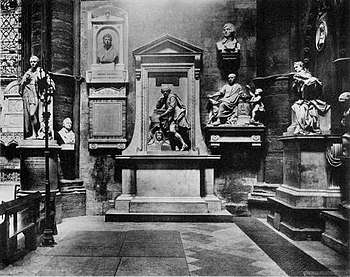
After a long career as an actor, dramatist, and sharer in the Lord Chamberlain's Men (later the King's Men) from c. 1585–90[lower-alpha 2] until c. 1610–13, William Shakespeare died in Stratford-upon-Avon, on 23 April 1616,[lower-alpha 3] and was buried in the chancel of the Church of the Holy Trinity two days later.
Shakespeare's works—both poetic and dramatic—had a rich history in print before the publication of the First Folio: from the first publications of Venus and Adonis (1593) and The Rape of Lucrece (1594), 78 individual printed editions of his works are known. c. 30% (23) of these editions are his poetry, and the remaining c. 70% (55) his plays. Counting by number of editions published before 1623, the best-selling works were Venus and Adonis (12 editions), The Rape of Lucrece (6 editions), and Henry IV, Part 1 (6 editions). Of the 23 editions of the poems, 16 were published in octavo; the rest, and almost all of the editions of the plays, were printed in quarto.[6] The quarto format was made by folding a large sheet of printing paper twice, forming 4 leaves with 8 pages. The average quarto measured 7 by 9 inches (18 by 23 cm) and was made up of c. 9 sheets, giving 72 total pages.[7] Octavos—made by folding a sheet of the same size three times, forming 8 leaves with 16 pages—were about half as large as a quarto.[6] Since the cost of paper represented c. 50–75% of a book's total production costs,[7] octavos were generally cheaper to manufacture than quartos, and a common way to reduce publishing costs was to reduce the number of pages needed by compressing (using two columns or a smaller typeface) or abbreviating the text.[6]
[Publish me in] the Smallest size,
Least I bee eaten vnder Pippin-pyes.
Or in th’ Apothicaryes shop bee seene
To wrap Drugg’s: or to dry Tobacco in.
First (might I chuse) I would be bound to wipe,
Where he discharged last his Glister-pipe.— Henry Fitzgeffrey, Certain Elegies (1618)
Editions of individual plays were typically published in quarto and could be bought for 6d (equivalent to £5 in 2019) without a binding. These editions were primarily intended to be cheap and convenient, and read until worn out or repurposed as wrapping paper (or worse), rather than high quality objects kept in a library.[7] Customers who wanted to keep a particular play would have to have it bound, and would typically bind several related or miscellany plays into one volume.[8] Octavos, though nominally cheaper to produce, were somewhat different. From c. 1595–96 (Venus and Adonis) and 1598 (The Rape of Lucrece), Shakespeare's narrative poems were published in octavo.[9] In The Cambridge Companion to Shakespeare's First Folio, Tara L. Lyons argues that this was partly due to the publisher, John Harrison's, desire to capitalize on the poems' association with Ovid: the Greek classics were sold in octavo, so printing Shakespeare's poetry in the same format would strengthen the association.[10] The octavo generally carried greater prestige, so the format itself would help to elevate their standing.[9] Ultimately, however, the choice was a financial one: Venus and Adonis in octavo needed four sheets of paper, versus seven in quarto, and the octavo The Rape of Lucrece needed five sheets, versus 12 in quarto.[10] Whatever the motivation, the move seems to have had the intended effect: Francis Meres, the first known literary critic to comment on Shakespeare, in his Palladis Tamia (1598), puts it thus: "the sweete wittie soule of Ouid liues in mellifluous & hony-tongued Shakespeare, witnes his Venus and Adonis, his Lucrece, his sugred Sonnets among his priuate friends".[11]
Pray tell me Ben, where does the mystery lurk,
What others call a play you call a work.— anonymous, Wits Recreations (1640)
Publishing literary works in folio was not unprecedented. Starting with the publication of Sir Philip Sidney's The Countess of Pembroke's Arcadia (1593) and Astrophel and Stella (1598), both published by William Ponsonby, there was a significant number of folios published, and a significant number of them were published by the men who would later be involved in publishing the First Folio.[lower-alpha 4] But quarto was the typical format for plays printed in the period: folio was a prestige format, typically used, according to Fredson Bowers, for books of "superior merit or some permanent value".[13]
Printing
The contents of the First Folio were compiled by John Heminges and Henry Condell;[14] the members of the Stationers Company who published the book were the booksellers Edward Blount and the father/son team of William and Isaac Jaggard. William Jaggard has seemed an odd choice by the King's Men because he had published the questionable collection The Passionate Pilgrim as Shakespeare's, and in 1619 had printed new editions of 10 Shakespearean quartos to which he did not have clear rights, some with false dates and title pages (the False Folio affair). Indeed, his contemporary Thomas Heywood, whose poetry Jaggard had pirated and misattributed to Shakespeare, specifically reports that Shakespeare was "much offended with M. Jaggard (that altogether unknown to him) presumed to make so bold with his name."[15]
Heminges and Condell emphasised that the Folio was replacing the earlier publications, which they characterised as "stol'n and surreptitious copies, maimed and deformed by frauds and stealths of injurious impostors", asserting that Shakespeare's true words "are now offer'd to your view cured, and perfect of their limbes; and all the rest, absolute in their numbers as he conceived them."
The paper industry in England was then in its infancy and the quantity of quality rag paper for the book was imported from France.[16] It is thought that the typesetting and printing of the First Folio was such a large job that the King's Men simply needed the capacities of the Jaggards' shop. William Jaggard was old, infirm and blind by 1623, and died a month before the book went on sale; most of the work in the project must have been done by his son Isaac.
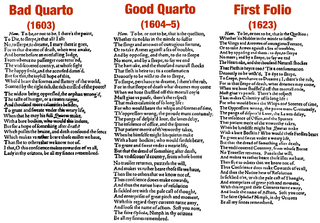
The First Folio's publishing syndicate also included two stationers who owned the rights to some of the individual plays that had been previously printed: William Aspley (Much Ado About Nothing and Henry IV, Part 2) and John Smethwick (Love's Labour's Lost, Romeo and Juliet, and Hamlet). Smethwick had been a business partner of another Jaggard, William's brother John.
The printing of the Folio was probably done between February 1622 and early November 1623. It is possible that the printer originally expected to have the book ready early, since it was listed in the Frankfurt Book Fair catalogue as a book to appear between April and October 1622, but the catalogue contained many books not yet printed by 1622, and the modern consensus is that the entry was simply intended as advance publicity.[17] The first impression had a publication date of 1623, and the earliest record of a retail purchase is an account book entry for 5 December 1623 of Edward Dering (who purchased two); the Bodleian Library, in Oxford, received its copy in early 1624 (which it subsequently sold for £24 as a superseded edition when the Third Folio became available in 1663/1664).[18]
Contents
The 36 plays of the First Folio occur in the order given below; plays that had never been published before 1623 are marked with an asterisk. Each play is followed by the type of source used, as determined by bibliographical research.[19]
The term foul papers refers to Shakespeare's working drafts of a play. When completed, a transcript or fair copy of the foul papers would be prepared, by the author or by a scribe. Such a manuscript would have to be heavily annotated with accurate and detailed stage directions and all the other data needed for performance, and then could serve as a prompt book, to be used by the prompter to guide a performance of the play. Any of these manuscripts, in any combination, could be used as a source for a printed text. The label Qn denotes the nth quarto edition of a play.
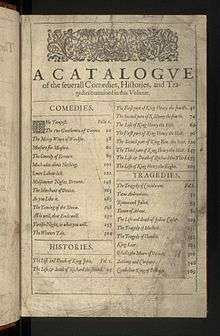
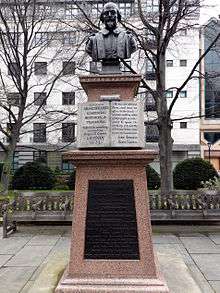
- Comedies
- 1 The Tempest * – the play was set into type from a manuscript prepared by Ralph Crane, a professional scrivener employed by the King's Men. Crane produced a high-quality result, with formal act/scene divisions, frequent use of parentheses and hyphenated forms, and other identifiable features.
- 2 The Two Gentlemen of Verona * – another transcript by Ralph Crane.
- 3 The Merry Wives of Windsor – another transcript by Ralph Crane.
- 4 Measure for Measure * – probably another Ralph Crane transcript.
- 5 The Comedy of Errors * – probably typeset from Shakespeare's "foul papers," lightly annotated.
- 6 Much Ado About Nothing – typeset from a copy of the quarto, lightly annotated.
- 7 Love's Labour's Lost – typeset from a corrected copy of Q1.
- 8 A Midsummer Night's Dream – typeset from a copy of Q2, well-annotated, possibly used as a prompt-book.
- 9 The Merchant of Venice – typeset from a lightly edited and corrected copy of Q1.
- 10 As You Like It * – from a quality manuscript, lightly annotated by a prompter.
- 11 The Taming of the Shrew * – typeset from Shakespeare's "foul papers," somewhat annotated, perhaps as preparation for use as a prompt-book.
- 12 All's Well That Ends Well * – probably from Shakespeare's "foul papers" or a manuscript of them.
- 13 Twelfth Night * – typeset either from a prompt-book or a transcript of one.
- 14 The Winter's Tale * – another transcript by Ralph Crane.
- Histories
- 15 King John * – uncertain: a prompt-book, or "foul papers."
- 16 Richard II – typeset from Q3 and Q5, corrected against a prompt-book.
- 17 Henry IV, Part 1 – typeset from an edited copy of Q5.
- 18 Henry IV, Part 2 – uncertain: some combination of manuscript and quarto text.
- 19 Henry V – typeset from Shakespeare's "foul papers."
- 20 Henry VI, Part 1 * – likely from an annotated transcript of the author's manuscript.
- 21 Henry VI, Part 2 – probably a Shakespearean manuscript used as a prompt-book.
- 22 Henry VI, Part 3 – like 2H6, probably a Shakespearean prompt-book.
- 23 Richard III – a difficult case: probably typeset partially from Q3, and partially from Q6 corrected against a manuscript (maybe "foul papers").
- 24 Henry VIII * – typeset from a fair copy of the authors' manuscript.
- Tragedies
- 25 Troilus and Cressida – probably typeset from the quarto, corrected with Shakespeare's "foul papers," printed after the rest of the Folio was completed.
- 26 Coriolanus * – set from a high-quality authorial transcript.
- 27 Titus Andronicus – typeset from a copy of Q3 that might have served as a prompt-book.
- 28 Romeo and Juliet – in essence a reprint of Q3.
- 29 Timon of Athens * – set from Shakespeare's foul papers or a transcript of them.
- 30 Julius Caesar * – set from a prompt-book, or a transcript of a prompt-book.
- 31 Macbeth * – probably set from a prompt-book, perhaps detailing an adaptation of the play for a short indoor performance
- 32 Hamlet – one of the most difficult problems in the First Folio: probably typeset from some combination of Q2 and manuscript sources.
- 33 King Lear – a difficult problem: probably set mainly from Q1 but with reference to Q2, and corrected against a prompt-book.
- 34 Othello – another difficult problem: probably typeset from Q1, corrected with a quality manuscript.
- 35 Antony and Cleopatra * – possibly "foul papers" or a transcript of them.
- 36 Cymbeline * – possibly another Ralph Crane transcript, or else the official prompt-book.
Troilus and Cressida was originally intended to follow Romeo and Juliet, but the typesetting was stopped, probably due to a conflict over the rights to the play; it was later inserted as the first of the tragedies, when the rights question was resolved. It does not appear in the table of contents.[20]
Introductory Poem
Ben Jonson wrote a preface to the folio with this poem facing the Droeshout portrait:
This Figure, that thou here seest put,
It was for gentle Shakespeare cut:
Wherein the Grauer had a strife
with Nature, to out-doo the life:
O, could he but haue dravvne his vvit
As vvell in brasse, as he hath hit
His face; the Print vvould then surpasse
All, that vvas euer vvrit in brasse.
But, since he cannot, Reader, looke
Not on his picture, but his Booke.
B.J.
Compositors
As far as modern scholarship has been able to determine,[21] the First Folio texts were set into type by five compositors, with different spelling habits, peculiarities, and levels of competence. Researchers have labelled them A through E, A being the most accurate, and E an apprentice who had significant difficulties in dealing with manuscript copy. Their shares in typesetting the pages of the Folio break down like this:
| Comedies | Histories | Tragedies | Total pages | |
|---|---|---|---|---|
| "A" | 74 | 80 | 40 | 194 |
| "B" | 143 | 89 | 213 | 445 |
| "C" | 79 | 22 | 19 | 120 |
| "D" | 35 1⁄2 | 0 | 0 | 35 1⁄2 |
| "E" | 0 | 0 | 71 1⁄2 | 71 1⁄2 |
Compositor "E" was most likely one John Leason, whose apprenticeship contract dated only from 4 November 1622. One of the other four might have been a John Shakespeare, of Warwickshire, who apprenticed with Jaggard in 1610–17. ("Shakespeare" was a common name in Warwickshire in that era; John was no known relation to the playwright.)
The First Folio and variants
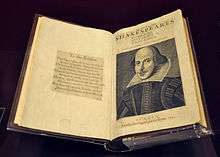
W. W. Greg has argued that Edward Knight, the "book-keeper" or "book-holder" (prompter) of the King's Men, did the actual proofreading of the manuscript sources for the First Folio. Knight is known to have been responsible for maintaining and annotating the company's scripts, and making sure that the company complied with cuts and changes ordered by the Master of the Revels.
Some pages of the First Folio – 134 out of the total of 900 – were proofread and corrected while the job of printing the book was ongoing. As a result, the Folio differs from modern books in that individual copies vary considerably in their typographical errors. There were about 500 corrections made to the Folio in this way.[22] These corrections by the typesetters, however, consisted only of simple typos, clear mistakes in their own work; the evidence suggests that they almost never referred back to their manuscript sources, let alone tried to resolve any problems in those sources. The well-known cruxes in the First Folio texts were beyond the typesetters' capacity to correct.
The Folio was typeset and bound in "sixes" – 3 sheets of paper, taken together, were folded into a booklet-like quire or gathering of 6 leaves, 12 pages. Once printed, the "sixes" were assembled and bound together to make the book. The sheets were printed in 2-page formes, meaning that pages 1 and 12 of the first quire were printed simultaneously on one side of one sheet of paper (which became the "outer" side); then pages 2 and 11 were printed on the other side of the same sheet (the "inner" side). The same was done with pages 3 and 10, and 4 and 9, on the second sheet, and pages 5 and 8, and 6 and 7, on the third. Then the first quire could be assembled with its pages in the correct order. The next quire was printed by the same method: pages 13 and 24 on one side of one sheet, etc. This meant that the text being printed had to be "cast off" – the compositors had to plan beforehand how much text would fit onto each page. If the compositors were setting type from manuscripts (perhaps messy, revised and corrected manuscripts), their calculations would frequently be off by greater or lesser amounts, resulting in the need to expand or compress. A line of verse could be printed as two; or verse could be printed as prose to save space, or lines and passages could even be omitted (a disturbing prospect for those who prize Shakespeare's works).[23]
Holdings, sales and valuations
Jean-Christophe Mayer, in The Cambridge Companion to Shakespeare's First Folio (2016), estimates the original retail price of the First Folio to be about 15s (equivalent to £139 in 2019) for an unbound copy, and up to £1 (equivalent to £185 in 2019) for one bound in calfskin.[lower-alpha 5] In terms of purchasing power, "a bound folio would be about forty times the price of a single play and represented almost two months’ wages for an ordinary skilled worker."[24]
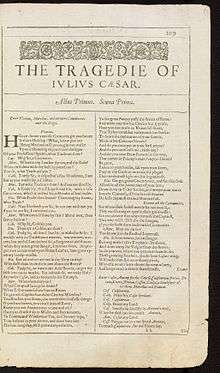
It is believed that around 750 copies of the First Folio were printed, of which there are 235 known surviving copies.[25][26][27] The British Library holds 5 copies. The National Library of Scotland holds a single copy, donated by the Society of Antiquaries of Scotland in 1949.[28] An incomplete copy is on display at the Craven Museum & Gallery in Skipton, North Yorkshire and is accompanied by an audio narrative by Patrick Stewart.[29] The Folger Shakespeare Library in Washington, D.C. holds the world's largest collection with 82 copies. Another collection (12 copies) is held at Meisei University in Tokyo, including the Meisei Copy (coded MR 774), said to be unique because of annotations by its reader.[30] While most copies are held in university libraries or museums such as the copy held by the Brandeis University library since 1961,[31] a few are held by public libraries. In the United States, the New York Public Library has six copies[32] with the Boston Public Library,[33] Free Library of Philadelphia,[34] The Rare Book & Manuscript Library (University of Illinois at Urbana-Champaign),[35] the Lilly Library (Indiana University-Bloomington),[36] and the Dallas Public Library[37] each holding one copy. The Huntington Library in Los Angeles County has four copies.[38] In Canada, there is only one known copy, located in the Thomas Fisher Rare Book Library of the University of Toronto.[39] The former Rosenbach copy, in its original binding, is now held at the Fondation Martin Bodmer in Switzerland.[40] The State Library of New South Wales holds copies of the First, Second, Third and Fourth Folios.[41] The only known copy in India is at IIT Roorkee.[42][43] California State Library - Sutro Library holds copies of the First, Second, Third, and Fourth Folios.[44]
The First Folio is one of the most valuable printed books in the world: a copy sold at Christie's in New York in October 2001 made $6.16 million hammer price (then £3.73m).[45]
Oriel College, Oxford, raised a conjectured £3.5 million from the sale of its First Folio to Sir Paul Getty in 2003.
To commemorate the 400th anniversary of Shakespeare's death in 2016, the Folger Shakespeare Library toured some of its 82 First Folios for display in all 50 U.S. states, Washington, D.C. and Puerto Rico.[46]
Discoveries of previously unknown Folios
On 13 July 2006, a complete copy of the First Folio owned by Dr Williams's Library was auctioned at Sotheby's auction house. The book, which was in its original 17th-century binding, sold for £2,808,000, less than Sotheby's top estimate of £3.5 million. This copy is one of only about 40 remaining complete copies (most of the existing copies are incomplete); only one other copy of the book remains in private ownership.[47]
On 11 July 2008, it was reported that a copy stolen from Durham University, England, in 1998 had been recovered after being submitted for valuation at the Folger Shakespeare Library. News reports estimated the folio's value at anywhere from £250,000 in total for the First Folio and all the other books and manuscripts stolen (BBC News, 1998), up to $30 million (The New York Times, 2008).[48] Although the book, once the property of John Cosin the Bishop of Durham, was returned to the library, it had been mutilated and was missing its cover and title page.[49] The folio was returned to public display on 19 June 2010 after its twelve-year absence.[50] Fifty-three-year-old Raymond Scott received an eight-year prison sentence for handling stolen goods, but was acquitted of the theft itself.[51] A July 2010 BBC programme about the affair, Stealing Shakespeare, portrayed Scott as a fantasist and petty thief.[52] In 2013, Scott killed himself in his prison cell.[53]
In November 2014, a previously unknown First Folio was found in a public library in Saint-Omer, Pas-de-Calais in France, where it had lain for 200 years.[25][54] Confirmation of its authenticity came from Eric Rasmussen, of the University of Nevada, Reno, one of the world's foremost authorities on Shakespeare.[25][54] The title page and introductory material are missing.[54][55] The name "Neville", written on the first surviving page, may indicate that it once belonged to Edward Scarisbrick, who fled England due to anti-Catholic repression, attended the Jesuit Saint-Omer College, and was known to use that alias.[25] The only other known copy of a First Folio in France is in the National Library in Paris.[55]
In March 2016, Christie's announced that a previously unrecorded copy once owned by 19th-century collector Sir George Augustus Shuckburgh-Evelyn would be auctioned on 25 May 2016.[56] According to the Antiques Trade Gazette, an American collector paid £1,600,000 for it; the buyer also successfully bid on copies of the second, third, and fourth folios.[57]
In April 2016 another new discovery was announced, a First Folio having been found in Mount Stuart House on the Isle of Bute, Scotland. It was authenticated by Professor Emma Smith of Oxford University.[58] The Folio originally belonged to Isaac Reed.[59]
Notes
- More generally, the term first folio is employed in other appropriate contexts, as in connection with the first folio collection of Ben Jonson's works (1616), or the first folio collection of the plays in the Beaumont and Fletcher canon (1647).
- The exact years of his London career are unknown, but biographers suggest that it may have begun any time from the mid-1580s to just before Robert Greene mentions Shakespeare in his Groats-Worth of Wit.[2][3][4]
- Dates follow the Julian calendar, used in England throughout Shakespeare's lifespan, but with the start of the year adjusted to 1 January (see Old Style and New Style dates). Under the Gregorian calendar, adopted in Catholic countries in 1582, Shakespeare died on 3 May.[5]
- Edward Fairfax's translation of Torquato Tasso's Godfrey of Bulloigne (1600), Thomas Heywood's Troia Britanica (1609), and Boccaccio’s Decameron (1620) was published in folio by William and Isaac Jaggard; Montaigne’s Essays (1603, 1613), Samuel Daniel’s Panegyricke Congratulatory (1603), Lucan’s Pharsalia (1614), and James Mabbe's translation of Mateo Alemán’s The Rogue (1623) were published by Edward Blount; and John Smethwick published Ben Jonson's Works (1616), and Michael Drayton's Poems (1619). All told, a quarter of the literary folios produced in London between 1600 and 1623 were the work of these three publishers.[12]
- He also cites previous estimates from Anthony James West, based in part on unpublished estimates by Peter Blayney, that the publisher's cost was about 6s 8d (equivalent to £61 in 2019), and the wholesale price no more than 10s (equivalent to £93 in 2019).[24]
References
- The Guardian 2015.
- Wells 2006, p. 28.
- Schoenbaum 1987, pp. 144–146.
- Chambers 1930, p. 59.
- Schoenbaum 1987, p. xv.
- Lyons 2016, p. 6.
- Lyons 2016, pp. 2–3.
- Lyons 2016, p. 10.
- Lyons 2016, p. 7.
- Lyons 2016, p. 8.
- Lyons 2016, pp. 8–9.
- Rasmussen 2016, p. 26.
- Lyons 2016, p. 1.
- Edmondson 2015, pp. 321–323.
- Erne 2013, p. 26.
- Higgins 2016, p. 41.
- Higgins 2016, p. 42–44.
- Smith 1939, pp. 257–264.
- Evans 1974.
- Halliday 1964, p. 420.
- Halliday 1964, p. 113.
- Halliday 1964, p. 390.
- Halliday 1964, p. 319.
- Mayer 2016, p. 105.
- Schuessler 2014.
- The Guardian 2016.
- Folgerpedia n.d.
- Vincent 2016.
- BBC 2011.
- Meisei University n.d.
- Farber 2013.
- West 2003, p. 222.
- West 2003, p. 204.
- Rasmussen & West 2012, p. 721.
- Rasmussen & West 2012, p. 585.
- "An Extraordinary Library: The Lilly Library, Indiana University". October 2015.
- Rasmussen & West 2012, p. 757.
- Rasmussen & West 2012, pp. 230–240.
- Rasmussen & West 2012, pp. 770–771.
- Rasmussen & West 2012, pp. 851–854.
- Rasmussen & West 2012, pp. 772–773.
- "Shakespeare's works, rare pictures await proper care at IIT-Roorkee". The Hindu. PTI. 2019-02-05. ISSN 0971-751X. Archived from the original on 2019-08-27. Retrieved 2019-08-27.CS1 maint: others (link)
- "Original 1623 edition of Bard's First Folio found at IIT Roorkee". The Times of India. 2019-02-05. Archived from the original on 2019-04-24. Retrieved 2019-08-27.
- "California State Library - Sutro Library catalog record for holdings on First Folio".
- Christie's 2001.
- Fessenden 2016.
- Iggulden 2006.
- Collins 2008.
- Wainwright 2010.
- Macknight 2010.
- Rasmussen 2011, p. 43.
- Rees 2010.
- BBC 2013.
- BBC 2014.
- Mulholland 2014.
- Finnigan 2016.
- Alex Capon (27 May 2016). "US collector splashes out £2.48m on four Shakespeare folios at Christie's". Antiques Trade Gazette.
- Coughlan 2016.
- Smith 2016.
Bibliography
- Ackroyd, Peter (2006). Shakespeare: The Biography. London: Vintage. ISBN 978-0-7493-8655-9.CS1 maint: ref=harv (link)
- "Rare Shakespeare folio goes on display in Skipton". BBC News. 21 March 2011. Retrieved 2 April 2018.
- "Shakespeare folio dealer Raymond Scott killed himself". BBC News. 9 December 2013. Retrieved 3 April 2018.
- "Shakespeare Folio found in French library". BBC News. 26 November 2014. Retrieved 3 April 2018.
- Bevington, David (2002). Shakespeare. Oxford: Blackwell. ISBN 0-631-22719-9.CS1 maint: ref=harv (link)
- Chambers, E. K. (1930). William Shakespeare: A Study of Facts and Problems. I. Oxford: Clarendon Press. ISBN 0-19-811774-4. OCLC 353406.CS1 maint: ref=harv (link)
- "Wliiam Shakespeare's First Folio Sells for $6,166,000 at Christie's New York, Establishing a World Auction Record for any 17th Century Book" (Press release). Christie's. 8 October 2001. Retrieved 2 April 2018.
- Collins, Paul (17 July 2008). "Folioed Again: Why Shakespeare is the world's worst stolen treasure". Slate. Retrieved 4 April 2018.CS1 maint: ref=harv (link)
- Coughlan, Sean (7 April 2016). "Shakespeare First Folio discovered on Scottish island". BBC News. Retrieved 3 April 2018.CS1 maint: ref=harv (link)
- Edmondson, Paul (2015). "His editors John Heminges and Henry Condell". In Edmondson, Paul; Wells, Stanley (eds.). The Shakespeare Circle: An Alternative Biography. Cambridge: Cambridge University Press. pp. 315–328. doi:10.1017/CBO9781107286580.030. ISBN 978-1107286580 – via Cambridge Core.CS1 maint: ref=harv (link)
- Erne, Lukas (2013). Shakespeare as Literary Dramatist (2nd ed.). Cambridge: Cambridge University Press. doi:10.1017/CBO9781139342445. ISBN 978-1139342445 – via Cambridge Core.CS1 maint: ref=harv (link)
- Evans, G. Blakemore, ed. (1974). The Riverside Shakespeare. Houghton Mifflin. ISBN 978-0395044025.
- Farber, Robert D. (3 October 2013). "Shakespeare collection". Brandeis Special Collections Spotlight. Brandeis University. Retrieved 2 April 2018.CS1 maint: ref=harv (link)
- Fessenden, Marissa (7 January 2016). "Shakespeare's First Folio Goes on Tour in the U.S." Smithsonian Magazine. Retrieved 2 April 2018.CS1 maint: ref=harv (link)
- Finnigan, Lexi (17 March 2016). "'Holy Grail' of Shakespeare's first Four Folios set to go on sale in London". The Telegraph. Retrieved 3 April 2018.CS1 maint: ref=harv (link)
- "First Folios at the Folger". Folgerpedia. Folger Shakespeare Library. n.d. Retrieved 2 April 2018.
- Greenblatt, Stephen (2005). Will in the World: How Shakespeare Became Shakespeare. London: Pimlico. ISBN 978-0712600989.CS1 maint: ref=harv (link)
- Greenblatt, Stephen (21 April 2016). "How Shakespeare Lives Now". The New York Review of Books. Vol. 63 no. 7. ISSN 0028-7504. Retrieved 6 April 2018.CS1 maint: ref=harv (link)
- "Ten books that changed the world". The Guardian. 7 August 2015. Retrieved 29 June 2017.
- "Shakespeare first folio discovered at stately home on Scottish island". The Guardian. 7 April 2016. Retrieved 2 April 2018.
- Halliday, F. E. (1964). A Shakespeare Companion 1564–1964. Baltimore: Penguin. LCCN 64005260. OCLC 683393. OL 16529592M.CS1 maint: ref=harv (link)
- Higgins, B.D.R. (2016). "Printing the First Folio". In Smith, Emma (ed.). The Cambridge Companion to Shakespeare's First Folio. Cambridge Companions to Shakespeare. Cambridge: Cambridge University Press. pp. 30–47. doi:10.1017/CCO9781316162552.004. ISBN 978-1316162552 – via Cambridge Core.CS1 maint: ref=harv (link)
- Honan, Park (1998). Shakespeare: A Life. Oxford: Clarendon Press. ISBN 978-0198117926.CS1 maint: ref=harv (link)
- Iggulden, Amy (14 July 2006). "Shakespeare First Folio sells for £2.8m". The Telegraph. Retrieved 3 April 2018.CS1 maint: ref=harv (link)
- Lyons, Tara L. (2016). "Shakespeare in Print Before 1623". In Smith, Emma (ed.). The Cambridge Companion to Shakespeare's First Folio. Cambridge Companions to Shakespeare. Cambridge: Cambridge University Press. pp. 1–17. doi:10.1017/CCO9781316162552.002. ISBN 978-1316162552 – via Cambridge Core.CS1 maint: ref=harv (link)
- Macknight, Hugh (18 June 2010). "Stolen Shakespeare folio is given its day in court". The Independent. Retrieved 2 April 2018.CS1 maint: ref=harv (link)
- Mayer, Jean-Christophe (2016). "Early Buyers and Readers". In Smith, Emma (ed.). The Cambridge Companion to Shakespeare's First Folio. Cambridge Companions to Shakespeare. Cambridge: Cambridge University Press. pp. 103–119. doi:10.1017/CCO9781316162552.008. ISBN 978-1316162552 – via Cambridge Core.CS1 maint: ref=harv (link)
- "Meisei University Shakespeare Collection Database". Meisei University. n.d. Retrieved 2 April 2018.
- Mulholland, Rory (25 November 2014). "Shakespeare First Folio discovered in French library". The Telegraph. Retrieved 3 April 2018.CS1 maint: ref=harv (link)
- Rasmussen, Eric (2011). The Shakespeare Thefts: In Search of the First Folios. St. Martin's Press. ISBN 978-0230341203.CS1 maint: ref=harv (link)
- Rasmussen, Eric (2016). "Publishing the First Folio". In Smith, Emma (ed.). The Cambridge Companion to Shakespeare's First Folio. Cambridge Companions to Shakespeare. Cambridge: Cambridge University Press. pp. 18–29. doi:10.1017/CCO9781316162552.003. ISBN 978-1316162552 – via Cambridge Core.CS1 maint: ref=harv (link)
- Rasmussen, Eric; West, Anthony James, eds. (2012). The Shakespeare First Folios: A Descriptive Catalogue. Oxford: Oxford University Press. ISBN 978-0230517653.CS1 maint: ref=harv (link)
- Rees, Jasper (30 July 2010). "Stealing Shakespeare, BBC One: Dodgy dealer, dodgy documentary". The Arts Desk. Retrieved 3 April 2018.CS1 maint: ref=harv (link)
- Schuessler, Jennifer (25 November 2014). "Shakespeare Folio Discovered in France". The New York Times. Retrieved 2 April 2018.CS1 maint: ref=harv (link)
- Smith, Emma (6 April 2016). "Vamped till ready". The Times Literary Supplement. Retrieved 3 April 2018.CS1 maint: ref=harv (link)
- Smith, Robert M. (1939). "Why a First Folio Shakespeare Remained in England". The Review of English Studies. Oxford University Press. 15 (59): 257–264. doi:10.1093/res/os-XV.59.257. eISSN 1471-6968. ISSN 0034-6551. JSTOR 509788.CS1 maint: ref=harv (link)
- Vincent, Helen (20 April 2016). "Shakespeare's First Folio". National Library of Scotland. Retrieved 2 April 2018.CS1 maint: ref=harv (link)
- Wainwright, Martin (9 July 2010). "Raymond Scott guilty of handling stolen folio of Shakespeare's plays". The Guardian. Retrieved 2 April 2018.CS1 maint: ref=harv (link)
- West, Anthony James (2003). A New World Census of First Folios. The Shakespeare First Folio: The History of the Book. II. Oxford: Oxford University Press. ISBN 978-0198187684.CS1 maint: ref=harv (link)
Further reading
- Blayney, Peter W. M. (1991). The First Folio of Shakespeare. Washington: Folger Shakespeare Library. ISBN 978-0962925436.
- Greg, W. W. (1955). The Shakespeare First Folio: Its Bibliographical and Textual History. Oxford: Clarendon Press. hdl:2027/mdp.39015016411061. OCLC 580880.
- Hinman, Charlton (1963). The Printing and Proof-Reading of the First Folio. Oxford: Clarendon Press. hdl:2027/mdp.39015002186073. ISBN 978-0198116134. OCLC 164878968.
- Pollard, Alfred W. (1923). The Foundations of Shakespeare's Text. London: Oxford University Press. hdl:2027/mdp.39015024389275. OL 7040376M.
- Schoenbaum, S. (1987). William Shakespeare: A Compact Documentary Life (Revised ed.). Oxford: Oxford University Press. ISBN 0-19-505161-0.CS1 maint: ref=harv (link)
- Smith, Emma (2015). The Making of Shakespeare's First Folio. Oxford: Bodleian Library, University of Oxford. ISBN 9781851244423.
- Smith, Emma (2016). Shakespeare's First Folio: Four Centuries of an Iconic Book. Oxford: Oxford University Press. ISBN 9780191069284.
- Walker, Alice (1953). Textual Problems of the First Folio: Richard III, King Lear, Troilus & Cressida, 2 Henry IV, Hamlet, Othello. Shakespeare problems. 7. Cambridge: Cambridge University Press. hdl:2027/mdp.39015015376612. OCLC 1017312216.
- Wells, Stanley (1997). Shakespeare: A Life in Drama. New York: W.W. Norton. ISBN 0-393-31562-2.CS1 maint: ref=harv (link)
- Wells, Stanley (2006). Shakespeare & Co. New York: Pantheon. ISBN 0-375-42494-6.CS1 maint: ref=harv (link)
- Willoughby, Edwin Eliott (1932). The Printing of the First Folio of Shakespeare. Oxford: Oxford University Press. hdl:2027/uc1.32106005244717. OCLC 2163079. OL 6285205M.
External links
| Wikimedia Commons has media related to First Folio. |
| Wikisource has original text related to this article: |
General resources
Digital facsimiles
- West 31 – The Bodleian Library's First Folio
- West 150 – The Boston Public Library's First Folio, digitized by the Internet Archive
- The Internet Shakespeare Editions
- West 153 – Brandeis University's First Folio, digitized for the Internet Shakespeare Editions project
- West 192 – The State Library of New South Wales's First Folio, digitized for the Internet Shakespeare Editions project
- West 6 – The University of Cambridge's First Folio
- Folger Shakespeare Library
- West 63 – Folger Folio no. 5
- West 65 – Folger Folio no. 7 – via EEBO (subscription required)
- West 67 – Folger Folio no. 9
- West 126 – Folger Folio no. 68
- West 77 – Folger Folio no. 19
- West 80 – Folger Folio no. 22
- West 91 – Folger Folio no. 33
- West 96 – Folger Folio no. 38
- West 101 – Folger Folio no. 43
- West 216 – The Bodmer Library's First Folio
- West 185 – The Harry Ransom Center's First Folio
- West 12 – The Brotherton Library's First Folio
- West 201 – Meisei University's First Folio
- West 174 – Miami University's First Folio
- West 192 – The State Library of New South Wales's First Folio
- West 180 – The Furness Library's First Folio
- Unnumbered – The Bibliothèque d’agglomération de Saint-Omer's First Folio (discovered in 2016, after the West census)
- West 197 – The Württembergische Landesbibliothek's First Folio
.png)